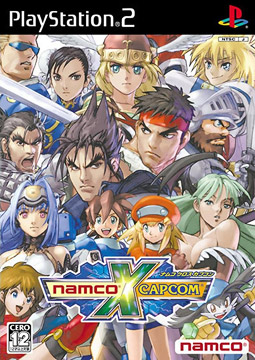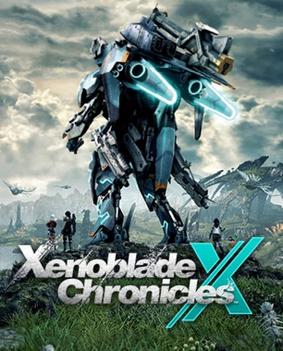Xenosaga is a role-playing video game series developed by Monolith Soft and primarily published by Namco. Forming part of the wider Xeno metaseries, Xenosaga is set in a science fiction universe and follows a group of characters as they face both a hostile alien race called the Gnosis and human factions fighting for control of the Zohar, an artifact connected to a god-like energy called U-DO. Gameplay across the series is similar, with the characters being guided through a linear narrative and fighting enemies using a turn-based combat system. The party fights both on foot and in a variety of mechs.

Monolith Software Inc., trading as Monolith Soft, is a Japanese video game development studio originally owned by Namco until being bought out by Nintendo in 2007, best known for the Xenoblade Chronicles series of games. The company was founded in 1999 by Tetsuya Takahashi with the support and cooperation of Masaya Nakamura, the founder of Namco. Their first project was the Xenosaga series, a spiritual successor to the Square-developed Xenogears. Multiple Square staff would join Takahashi at Monolith Soft including Hirohide Sugiura and Yasuyuki Honne.

Baten Kaitos: Eternal Wings and the Lost Ocean is a role-playing video game developed by Monolith Soft and tri-Crescendo and published by Namco for the GameCube. In it, the player assume the role of a "guardian spirit" – an unseen player avatar – who guides protagonist Kalas and his party of companions in an adventure across an aerial floating island-based kingdom in the clouds. The game is focused around the concept of "Magnus" – magical cards that capture the "essence" of items found in the in-game world. The concept is used as a plot device, for in-game item management, and as a basis for the card-themed battle system. The game was noted for its unique battle system, which included aspects of turn-based and action-based battle systems, collectible card games, and poker.
Tetsuya Takahashi is a Japanese video game designer, writer and director. Takahashi worked at Square in the 90s as a graphic designer and graphic director, participating on some of their most well-received titles such as Final Fantasy V, Final Fantasy VI and Chrono Trigger, before directing and co-writing Xenogears. He left Square in 1999 to co-found Monolith Soft, where he would develop the Xenosaga and Xenoblade Chronicles series with Namco and Nintendo respectively, being the executive director of Xenoblade since the first entry in the series.

Xenosaga I & II is a 2006 role-playing video game co-developed by Monolith Soft and Tom Create, and published by Namco for the Nintendo DS. A spin-off of the Xenosaga trilogy and forming part of the Xeno metaseries, Xenosaga I & II retells the events of Xenosaga Episode I and Xenosaga Episode II while expanding on its characters and narrative. Displayed from an angled two-dimensional perspective, Xenosaga I & II makes use of a turn-based battle system with elements carried over from the main Xenosaga games.

Namco × Capcom is a tactical role-playing (RPG) crossover video game developed by Monolith Soft for the PlayStation 2 and published by Namco in 2005. The gameplay combines tactical RPG and action sequences during battles, featuring characters from video game series owned by Namco and Capcom. The narrative sees original characters Reiji Arisu and Xiaomu, operatives for paranormal investigative group Shinra, confront distortions bringing characters from other realities into their own.

Xenosaga: The Animation is a mecha anime produced by Toei Animation. The 12-episode series ran from January to March 2005 on TV Asahi, while it was licensed for release on DVD overseas first by A.D. Vision and later by Funimation Entertainment. The anime is based on the narrative of Xenosaga Episode I, a role-playing game for the PlayStation 2 developed by Monolith Soft and published by Namco. Set 5000 years in the future, it tells of the adventures of scientist Shion Uzuki and the battle android KOS-MOS as they fight the threat of the alien Gnosis.
The following is a list of Xenosaga characters.
Kaori Tanaka, also known by her pen name, Soraya Saga, is a freelance Japanese illustrator, designer, and video game story writer.

Xenosaga Episode I: Der Wille zur Macht is a role-playing video game developed by Monolith Soft and published by Namco for the PlayStation 2; the game was released in 2002 in Japan and 2003 in North America. It is the first entry in the Xenosaga trilogy and forms part of the wider Xeno metaseries. Gameplay features exploration of environments through a linear narrative, while battles use turn-based combat with the player characters fighting both on foot and piloting large mecha dubbed A.G.W.S.; combat in turn features a system of button combinations for attack types, and multiple leveling systems.

Xenosaga Episode II: Jenseits von Gut und Böse is a 2004 role-playing video game developed by Monolith Soft for the PlayStation 2. It was published in Japan (2004) and North America (2005) by Namco, and in Europe by Sony Computer Entertainment Europe (2005). It is the second entry in the Xenosaga trilogy, and forms part of the wider Xeno metaseries. Continuing directly from the events of Xenosaga Episode I, Xenosaga Episode II sees protagonists Shion Uzuki and Jr. continuing to combat the plots of the U-TIC Organization and the insane Albedo Piazzolla. Gameplay is carried over from the first game, featuring exploration of environments through a linear narrative, while battles follow a turn-based system featuring a system of button combinations, multiple leveling systems, and combat featuring both the characters on foot and piloting large mecha called "E.S.".

Xenosaga Episode III: Also sprach Zarathustra is a role-playing video game developed by Monolith Soft and published by Namco Bandai Games for the PlayStation 2 in 2006. It is the final entry in both the Xenosaga trilogy and the larger Xenosaga series, which forms part of the Xeno franchise. Concluding the narrative of Xenosaga Episode I and Episode II, Episode III sees Shion Uzuki and the battle android KOS-MOS search out the origins of the hostile alien Gnosis while being hunted by Shion's former employers and four powerful humans called the Testaments. Gameplay is carried over from the first two games, featuring exploration of environments through a linear narrative, while battles follow a turn-based system featuring multiple leveling systems and combat with both a human party and mecha.
Yasuyuki Honne is a video game artist, director and producer. He was employed by Square from 1993 to 1999 and is now working at Monolith Soft. He is known for his work on the Chrono series, Xeno games and Baten Kaitos series.

Soma Bringer is a 2008 action role-playing game developed by Monolith Soft and published by Nintendo for the Nintendo DS. The player, controlling one of the eight main characters, explores dungeons and fights enemies in real-time combat across three-dimensional plains from a top-down perspective. Multiplayer functions allow up to three players to participate in exploration and combat. The story focuses on the continent of Barnea: the principle magical energy, Soma, is being disrupted by the arrival of monsters called Visitors, prompting a military group called Pharzuph Division 7 to defeat the Visitors and restore the balance of Soma.
The Xenosaga (ゼノサーガ) series is a series of science fiction role-playing video games developed by Monolith Soft and published by Namco Bandai on the PlayStation 2. The series began with the 2002 release of Episode I: Der Wille zur Macht, which was followed in 2004 by Episode II: Jenseits von Gut und Böse and in 2006 by Episode III: Also sprach Zarathustra. The music of Xenosaga includes the soundtracks to all three chapters, as well as the music for its spin-off media. These include Xenosaga Freaks, a set of minigames set between the first two chapters, Xenosaga I & II, a Nintendo DS remake of the first two chapters, and Xenosaga: The Animation, an anime series covering the events of the first game. Episode I was composed by Yasunori Mitsuda, Episode II was split between Yuki Kajiura, Shinji Hosoe, and Ayako Saso, and Episode III was composed by Kajiura alone. Xenosaga Freaks reused some of the music of Episode I by Mitsuda while also including new work by Shinji Hosoe, Ayako Saso, Masashi Yano, Keiichi Okabe, Satoru Kōsaki, and Hiroshi Okubo, while Xenosaga I & II and Xenosaga: The Animation used new pieces composed by Kousuke Yamashita.

Xeno is a Japanese science fantasy video game franchise created by Tetsuya Takahashi. The first entry was developed by SquareSoft, and subsequent entries have been developed by Monolith Soft, a company founded by Takahashi after he left Square in 1999. While the various games have no direct story connections, they have common thematic links and all sport the "Xeno" prefix, which Takahashi has variously described as a means of identifying his games and a symbolic representation of the series. All the games in the Xeno meta series take place within a science fiction setting with some fantasy elements, with its stories frequently featuring psychological, philosophical, and religious themes.

Xenoblade Chronicles X is a 2015 action role-playing game developed by Monolith Soft and published by Nintendo for the Wii U console. Xenoblade Chronicles X forms part of the Xeno metaseries, being a spiritual successor to Xenoblade Chronicles without any narrative connections to prior Xeno titles. Carrying over several gameplay elements from Xenoblade Chronicles, players explore the open world planet Mira, completing a variety of quests and unlocking new regions to explore and gather resources from across Mira's five continents.

Xenoblade Chronicles 2 is a 2017 action role-playing game developed by Monolith Soft and published by Nintendo for the Nintendo Switch. It is the third installment in the Xenoblade Chronicles series and the seventh main entry in the Xeno series, and was released on December 1. Plans for the game began shortly before the launch of Xenoblade Chronicles X in 2014. Key developers from previous games returned, including franchise creator Tetsuya Takahashi and directors Koh Kojima and Genki Yokota. The team wanted to develop a story-driven game in the style of the original Xenoblade Chronicles. The game was announced in 2017 and was released worldwide the same year. As with Xenoblade Chronicles, the game was localized by Nintendo of Europe.

Xenoblade Chronicles is a series of action role-playing games developed by Monolith Soft and published by Nintendo. The series began with the original Xenoblade Chronicles game, published for the Nintendo Wii in 2010. Though initially only released in Japan, it was localized into other regions as a result of Operation Rainfall, a large grass-roots fan campaign to pressure Nintendo to localize several Japan-exclusive games. The original game became a critical and commercial success, spawning multiple sequels. The series has since sold more than 8.2 million copies worldwide. Xenoblade Chronicles has been well-received for its world design, music, stories, and themes. The series has been represented in other gaming franchises, including the Super Smash Bros. and Project X Zone series. It is loosely a part of the Xeno metaseries, for which it receives its namesake, co-created and directed by Tetsuya Takahashi.

Super Robot Taisen OG Saga: Endless Frontier Exceed is a crossover role-playing video game co-developed by Monolith Soft and Banpresto and published by Namco Bandai Games for the Nintendo DS (DS) in 2010. Forming part of the Super Robot Wars series, Endless Frontier Exceed is a sequel to the 2008 DS game Super Robot Taisen OG Saga: Endless Frontier, carrying over its gameplay elements.














